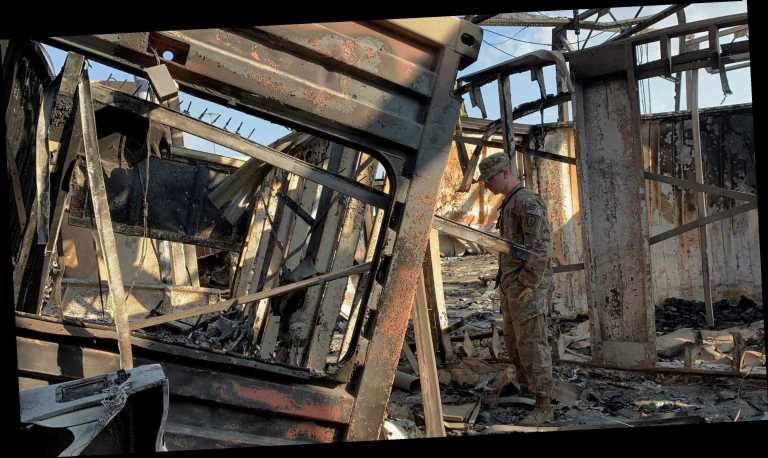Reports that several U.S service members were treated for concussion symptoms following Iran’s missile assault on Iraqi bases are raising questions about how soon officials knew of the injuries.
The Jan. 8 airstrike was an apparent retaliation for a U.S. drone strike days earlier that killed one of Tehran’s most powerful officials. Iran bombed Al Assad and Erbil bases early that morning, around 1:20 a.m. local time.
About 18 hours later, President Donald Trump said in an address to the nation that, “no Americans were harmed in last night’s attack by the Iranian regime. We suffered no casualties, all of our soldiers are safe, and only minimal damage was sustained at our military bases.”
But “in the days following the attack,” 11 people were taken out of Iraq for medical screening, according to a statement from the U.S. Central Command in the region Thursday.
“Several were treated for concussion symptoms from the blast and are still being assessed,” the statement said.
Iran missile attack: 11 US troops treated for injuries
“As a standard procedure, all personnel in the vicinity of a blast are screened for traumatic brain injury, and if deemed appropriate are transported to a higher level of care. In the days following the attack, out of an abundance of caution, some service members were transported from Al Asad Air Base, Iraq to Landstuhl Regional Medical Center in Germany, others were sent to Camp Arifjan, Kuwait, for follow-on screening,” the statement continued.
The service members were expected to return to Iraq after the screening, the statement said.
What are concussions and their symptoms?
Concussions are mild forms of traumatic brain injuries. Common symptoms of concussions – headache, memory loss and confusion – may not show up immediately, according to the Mayo Clinic. The symptoms can last for days, weeks or longer.
“Some of these symptoms may appear right away. Others may not be noticed for days or months after the injury, or until the person resumes their everyday life,” according to the CDC.
Concussions are usually caused by a blow to the head. Some but not all concussions can cause you to lose consciousness.
Daniel Torres, a neurologist at NYU Langone’s Concussion Center, said concussion injuries always cause some form of initial symptoms.
“There needs to be some symptom at the time of the event, but then, over time, the symptoms can change. Even though you need to have something early, you might be dizzy at first and the next day start having headaches. Or you might get a headache and not feel dizzy until a couple days later,” he said.
But it makes sense that reports of concussion symptoms would not come to light immediately, Torres said.
“If you’re in the field and being attacked, and there are minor symptoms early on, the adrenaline surge that you get is something that could get you to ignore the early symptoms to deal with the emergency that’s in front of you. So you might not immediately report what’s going on,” Torres said. “Sometimes if people have a minor injury, they might think they’ll shake it off.”
Here’s how the horror unfolded: Calm after missile strikes, then a fiery plane crash
What has the Pentagon said about the troops’ injuries?
Pentagon leadership learned of the injures Thursday, a spokesperson said.
“The Pentagon leadership was notified of the injuries yesterday. The Commander in Iraq met all reporting requirements and took the appropriate steps to ensure the service members received the proper level of care,” Press Secretary Alyssa Farah said on Twitter.
The vast majority of service members examined after the missile attack showed no sign of concussive injury and returned to duty, Farah said.
Eleven service members were taken to facilities in Germany and Kuwait because MRI equipment is available there, Farah said.
The Pentagon leadership was notified of the injuries yesterday. The Commander in Iraq met all reporting requirements and took the appropriate steps to ensure the service members received the proper level of care.
The ‘signature injury’ of wars in Iraq, Afghanistan
More than 400,000 service members have been diagnosed with a traumatic brain injury since 2000, according to the Defense and Veterans Brain Injury Center. In 2017, there were nearly 18,000 diagnoses, down from a recent peak of nearly 33,000 in 2011.
The greatest number of cases occur in the Army, the largest military branch.
Service members can sustain a concussion during day-to-day activities, military training and military deployment, according to the DVBIC. Most service members who sustain a concussion return to full duty within seven to 10 days.
Brain injuries related to blast exposures from improvised explosive devices (IEDs) have been called the “signature injury” of the wars in Iraq and Afghanistan due to the significantly high prevalence in veterans previously deployed in these regions, according to the Journal of Military and Veterans’ Health.
“Part of the reason we see more of these now is that body armour prevents shrapnel from going into your body and head. So you see more people survive. Unfortunately, all that body armour is not technology that prevents concussions. So you end up with a lot more people coming back with those,” Torres said.
Brain injuries caused by blast concussions have been linked to difficulties of returning personnel with reintegrating into civilian society.
“The recovery from concussion is even more complicated than the injury itself. But that’s different from person to person. Someone who has headaches and problems reading and is anxious is going to have a much harder time than someone who is a little off balance,” Torres said. “These problems sometimes feed off each other.”
Source: Read Full Article
